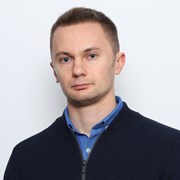The transition from a conventional net based caged to a closed cage is not trivial. When the volume is closed the water inside is forces to move with the cage, and the mass of the enclosed water must then be included in the effective mass of the whole structure. This is highly different from net based cages where the water is allowed to move more or less freely in and out of the enclosed volume, and the mass of the enclosed water is not coupled to the mass of the structure. Due to this, the mass of a closed cage will have an effective mass several thousand times larger than a net-based cage. The mass of a structure dictates the forces involved, and therefore a closed cage will behave very different than a conventional cage.
Additionally, a closed cage will experience the phenomenon of sloshing (free surface waves in the enclosed volume). This is a resonance problem where large wave motion can be generated at certain wave periods, something that will greatly influence the behaviour of the structure.
There are few examples of flexible floating structures with features similar to closed aquaculture cages. Consequently, there are limited knowledge on how these structures behave, and there are no numerical models that can adequately predict response in waves. This project will, mainly through model experiments, increase the understanding of closed cages in waves; its structural response, sloshing and internal flow. This understanding will be used to formulate and implement a numerical model that can be used to simulate closed cages in waves. The project will include flexible (bag/tarpaulin), semi-flexible (grp etc.) and rigid cages (concrete).
Primary objective:
Increase the safety of closed aquaculture cages in waves by understanding, predicting and controlling the response of such structures in waves.
Secondary objectives:
- Understand the structural response of closed cages in waves.
- Understand the internal wave response in closed cages in waves (sloshing) and find methods to control and prevent this.
- Understand the interaction between the internal flow and the internal wave response.
- Develop the first version of a numerical model for estimating the behaviour of closed cages in waves.
Impact
Fish farming in floating closed cages has gained increased interest in the Norwegian aquaculture industry, both due to reported promising results relative to key production parameters as growth, mortality and fish health and due to access to new licenses for production. Some of the floating closed cage concepts have also met challenges due to unexpected wave induced effects and loads that in some cases have caused damages of the structure with the risk of fish escapes. Increased knowledge about general hydrodynamic aspects of floating closed cages will potentially lead to more robust and reliable structures e.g. through new or improved technical standards, or through development of rational design criteria and guidelines. Increased knowledge among equipment producers about general hydrodynamic aspects of closed containment systems might also reduce the cost of innovation and design processes, as known general issues can be avoided.
Reliable structure concepts are important to avoid escapes of farmed fish and the associated environmental impact and to improve the public opinion about the industry. Increased knowledge about such concepts might help to increase production in floating closed containment systems, e.g. by make possible use of new production areas and facilitate new production regimes for smolt. Larger and more robust smolt are better prepared for growth phase in open cages at exposed locations. Increased fish farming in closed containments can also reduce the impact of sea-lice as well as reduce local environmental impact if waste is collected.

